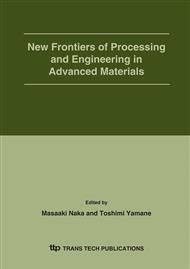p.275
p.281
p.287
p.291
p.297
p.303
p.309
p.315
p.321
Preparation of Super-Hard Nanocomposite Films by ICP Assisted Magnetron Sputtering
Abstract:
Super-hard nanocomposite films were deposited on Si(100) substrates with irradiation of a high-density (~2.0 mA/cm2) low-energy (~22 eV) ion flux by an inductively coupled plasma (ICP) assistance to magnetron sputtering process. Low-stress, super-hard nanocomposite Ti-Cu-N and Ti-Si-N films could be synthesized at low deposition temperatures below 300 oC. Prepared films exhibited a pronounced TiN(200) texture and the film hardness was significantly enhanced by the addition of Cu and Si, where a maximum value of 42 GPa at approximately 2 at% Cu addition and 48 GPa at approximately 5.8 at.% Si. Ti-Cu-N films were consisting of nanocolumns of TiN crystallites with dispersion of Cu crystallites around the columnar boundaries. While Ti-Si-N films were characterized as having a nanocolumns of TiN crystallites with amorphous Si3N4 inside the columnar boundaries. The residual compressive stresses of these films were lower than 1.5 GPa and no refinement of crystallite size by the addition of Cu and /or Si was observed, from which the hardness enhancement was attributed to a nanocomposite effect.
Info:
Periodical:
Pages:
297-302
Citation:
Online since:
December 2005
Authors:
Keywords:
Price:
Сopyright:
© 2005 Trans Tech Publications Ltd. All Rights Reserved
Share:
Citation:


